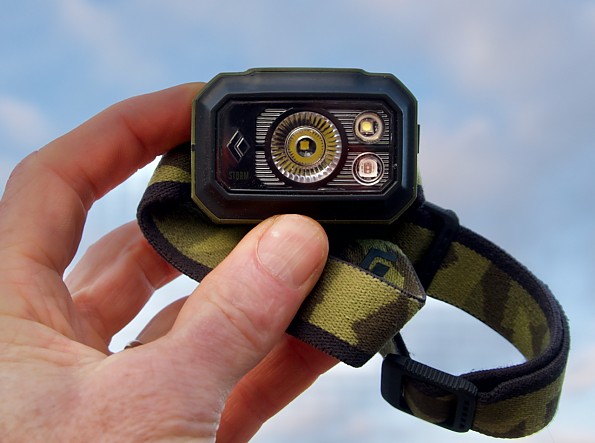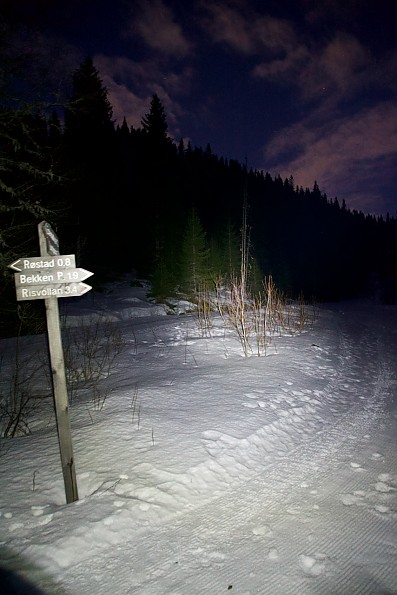Black Diamond Storm 375
The Storm 375 has been discontinued. It was replaced by the Black Diamond Storm 450.

A great all-round headlamp with a broad range of lighting options for different situations, including low intensity flood light for tent and hut use, a moderately powerful spot LED that is good enough for downhill skiing on groomed trails or in good snow, and red, blue, or green floods for night vision. Long battery life with judicious use. Great for night running and xc skiing or biking at moderate speeds, backpacking, and around hut or camp.
Pros
- Versatile lighting options for users who don’t want to just turn night into day
- 375 lumens just enough for night xc skiing
- Small and light
- Uses replaceable AAA batteries
- Good battery life
Cons
- Stiff tilt adjustment takes two hands
- Many folks online complaining of battery life problems (not experienced by this reviewer)
- Inner batteries hard to change
- Internal Li-ion might be better in many uses
- Could use some padding on the forehead
When friends and family back home ask me how I get through the long, dark winter nights in Norway, I usually answer in two words: “Vitamin Ski”!
On the shortest days of the year here in Trondheim, the sun is up for a little more than four hours, and for a month on either side of winter solstice I leave for work and come home in darkness on roads and bike paths lit by streetlamps. But I am fortunate to have a cross-country ski trail passing within 100 meters of the front door, my entry to the 50 km network of groomed trails in Estenstadmarka, the city forest park on the east side of the city. When I get home from work, or after dinner, or before breakfast, I can grab a pair of skis and slip into darkness for an hour or two.
The hardest thing about it is getting out the door—once I’m out there it’s usually at least rewarding and sometimes downright delightful to be out and moving over snow, either by whatever light is available or using a headlamp. If the snow is too thin or the trails are too icy, studded running shoes take the place of skis. About 10 of the 50 km are lighted, but only in the evening from late afternoon until 11PM, and a lot of the best trails are on the higher terrain and unlighted. So a good headlamp, or better yet a selection of headlamps (the BD Storm is approximately the 13th headlamp in our household collection, not counting hand lights and lanterns), is an essential part of the Vitamin Ski cure.
Some of the locals, especially the competition-minded, go in for super-powerful (and expensive) lights that throw thousands of lumens (there’s one model that goes to 12—thousand, that is), sometimes blinding those of us of lesser luminosity. Some people even use them for an extra boost on the lighted trails. I guess when you’ve spent 5000 kroner (more than $500) on a headlamp you really want to use it.
I prefer to get by on a reasonable minimum, both light- and cost-wise. Often there’s enough city light reflected off of clouds to illuminate the trails in an eerie, diffuse orange glow. On a clear night, a half to full moon can make double poling across the open bog areas in sparkling snow an absolute delight, no artificial light needed. Under those kinds of conditions, the headlamp gets switched on only in the deep shade of the spruce forest and on steeper downhills. In the former situation it can be nice to ski with just enough light to illuminate the track a little way ahead, with the darkness otherwise folded around me. On the downhills, I need a beam powerful enough to both read the snow surface in front of my ski tips and look out for obstacles and twists and turns as much as 50 meters ahead.
The versatile BD Storm 375 delivers on those needs, with short-distance flood illumination in white; night vision red, green, or blue light for mellow kick-and-glide through the forest; and a spot beam that combines with the white flood to give 375 lumens, just powerful enough to run at 40 km (25 mi) an hour down a groomed xc trail, all continuously tunable to meet the needs of the moment.
A good thing in a small package
The angled, flat surfaces of its case give the Storm a bit of a Millennium Falcon look. My test model is olive green and black with a camo head strap for a military touch, but the Storm 375 is available in five other colors to match your favorite outerwear. I weighed the empty headlamp at 53 g / 1.9 oz, the strap at 16 / 0.6, and a set of AAAs at 40 / 1.4, for a total operating weight of about 110 g / 3.9 oz, light enough on the forehead to have an occasional “where is my headlamp?” moment. BD says it’s waterproof to 1 meter; I am taking their word for it at least for the time being.
The head strap has a soft finish and the material is a little thicker than on most of my other headlamps, giving it a soft feel on the forehead. It passes through split brackets on the back of the headlamp so that the strap can be removed for mounting the headlamp on a pack strap, belt, or helmet. Although I haven’t had use for it, that seems like a nice detail.
Unlike its predecessor, the Storm 350, the 375 does not have any extra padding for the forehead, relying instead on a short length of exposed head strap for both padding and friction to keep it from slipping—I don't like to have too tight a head strap because it can give me headaches. I have worn it mostly over a hat or buff, but on a recent, relatively warm morning when I wore it on a bare forehead, I found it just a little too firm and it felt slightly unstable, so I think it would benefit from a little extra padding.
Tilt adjustment
Rather than pointing straight ahead, the headlamp comes with a slight forward tilt built in, and adjusts four clicks to a downward angle of about 45˚. The starting position is just about right for lighting the trail ahead using the spot, but sometimes when heading downhill or using the white or colored floods I find I want to angle it down a click to better see the snow right in front of me. I find the tilt adjustment ratchet to be a little stiff and hard to adjust one-handed, especially with glove or mittens. Because I am often changing lighting modes on the fly with ski pole in hand, the system would work better for me if the angle adjustment, whether ratcheted or continuous, worked a little more smoothly.
Overall the construction is solid and it seems like this headlamp can tolerate being dropped or banged around; so far I have not purposefully or inadvertently tested that.
The right light (lighting modes)
This is where the Storm really (ahem) shines, with lighting options for a wide variety of situations. I haven’t found brightness specs for the individual LEDs, but BD gives the max (with both spot and white flood LEDs combined) at 375 lumens, mid-range at 160 lumens, and low power at 8 lumens, with effective lighting distances of 100, 45, and 9 meters or roughly 300+/150/30 feet, respectively. Here’s how I break down the options:
- Ca. 300 lumen spot, tunable down to something like 8 lumens
- Ca. 75 lumen white flood, also tunable to a very low level
- Combine spot and flood for simultaneous near and far illumination
- Choice of red, green, or blue night-vision floods, also tunable
- Spot, flood, and colored lights can be set to flash about 3 times per second.
- PowerTap: a touch or pinch grip on the right side switches full power on or off for whatever mode you're in
- Brightness memory: remembers last setting when switching off
- Automatic low-power reserve mode stretches out battery life for 2+ days
High beam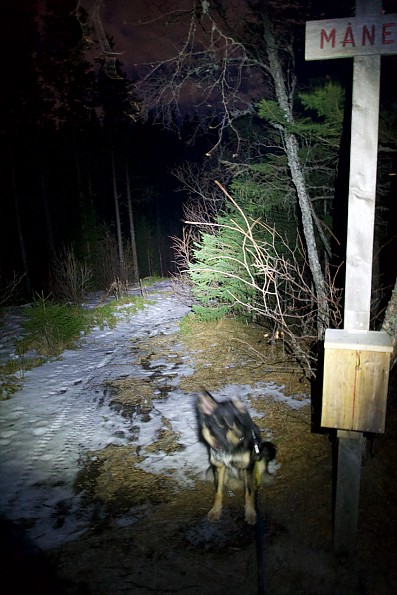 (Harley was a little too restless for the shutter speed...)
(Harley was a little too restless for the shutter speed...)
For me the spot LED on full power is just bright enough for bombing down well-groomed xc ski trails at speeds approaching 40 km / 25 mi per hour. It's nice to have the flood on as well so that I can read the snow in front of my ski tips. With harder or rougher conditions, I need to slow it down a bit and might appreciate a bit more light (I heard from a little birdie that BD is coming out with a 400-lumen version, with shorter battery life as the trade-off).
The promo video on BD’s web page opens with a group of mountain bikers; as with ski trail conditions I think this light would be fine for biking on dirt roads or smooth trails, but for traveling fast on rough terrain you probably want more light. I can easily see doing some tree skiing in good snow with this light and hope to try just that later this season.
Night sight
For xc skiing on flats and uphills, I like to go by natural or reflected city light if possible, but if there’s not quite enough of that I have been using the colored LEDs at medium to full power for night vision. I can read the tracks and snow surface far enough ahead to avoid unpleasant surprises like dirty or icy patches or chunks of snow left by the groomer, but I’m not blinded by white light so I can also see ahead by whatever other light is available, enough to see the trail corridor outlined by trees and maybe even the silhouette of a roe deer darting across the trail ahead.
In trying out the three colors, I noticed that green seems to give better vision than red and blue at the same power level. At first I thought red would be the natural choice on the grounds that many nocturnal critters can't perceive red light, but then I found this technical discussion of why green at very low intensity is actually a better color for preserving night vision.
Here are some photos taken with the four floods at maximum output: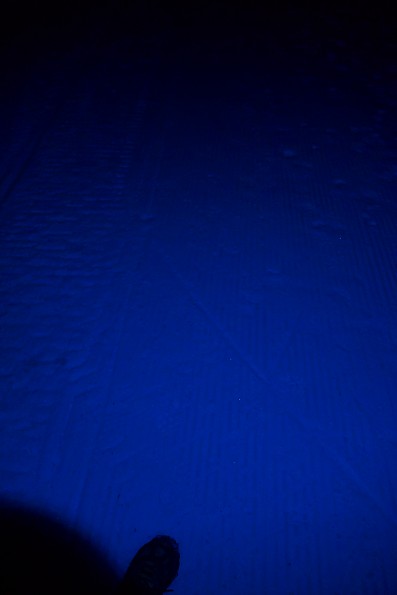
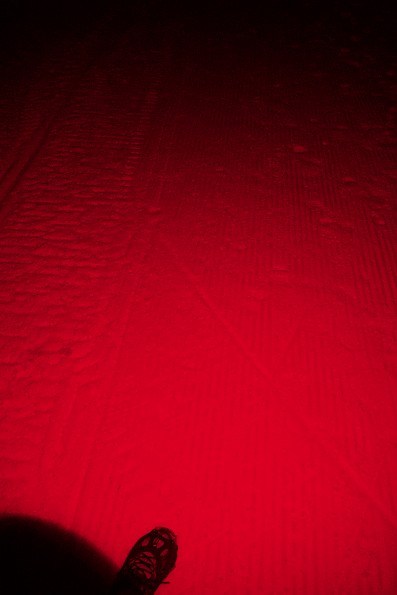
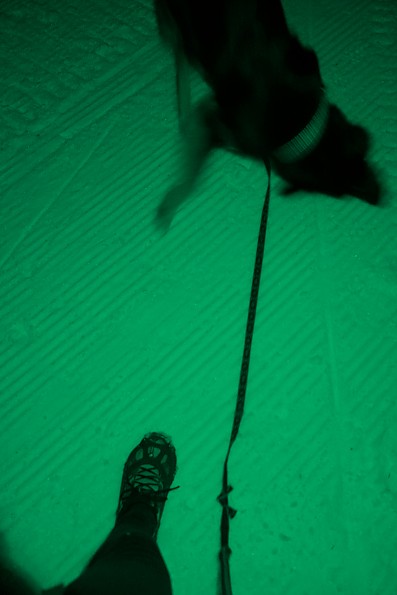

After a spell of warm January weather compromised the ski conditions, I went for an early morning trail run and tried running with the flood LEDs in all four options at minimum output (too dim to take photos). As the photos above show, red and blue are OK for lighting up snow, but green and white give substantially more detail. When it came to running over melted-out trails and dirt roads I couldn't really distinguish puddles or other dark-on-dark features on the lowest light settings, so it would probably be a good idea to turn up the floods to at least medium power for night running in summer darkness. The floods on low (or reserve) would be fine for the relatively slow business of night hiking on a well-defined trail, but on a real dark night you wouldn't see much more than a circle of light a few meters ahead of your feet.
The white flood LED at low to medium power is the right choice for indoors use in huts and tents, offering enough light for cooking, reading, and the like without blinding the wearer or her friends. Rigorous testing reveals that at low power it is about perfect for reading in bed or while making deposits in the outhouse, and it's good for reading maps as well.
The Storm OS
Ease of use
The 375 is an upgrade of BD's 350 lumen, one-button Storm 350, which is also in my collection. In addition to the extra lumens, the 375 has a second button that, with some training, makes it much easier and more intuitive to access the lighting options. Both buttons give minimal tactile feedback, just a light click-feel, more so on the round user-left button. This can lead to a tendency to push the buttons a little harder than necessary, at least at first. It doesn’t really take much force to switch the light on, so it’s a good idea to use the lockout option, switched both on and off by holding both buttons down, for stowing in a pocket or pack.
Powertap
A third control, called PowerTap, appears as a tiny black indent in the colored shell on the right side of the light (visible in the right side photo above). Tapping this little spot with a finger toggles between whatever mode you are in and full power for that mode, i.e. if you are at half red it will go to full red, then back to half red with another tap. One place this might come in handy is to prevent blinding people coming the other way, like turning down the high beams in a car.
With a little experience, I can find I can operate the two main buttons with various gloves or even mittens, but I need a pinch grip on the whole headlamp to reliably use the PowerTap control with heavier gloves or mittens. That’s a little awkward as I’m starting down a hill with a ski pole dangling from my wrist, so the PowerTap is not quite as useful in cold conditions. It’s a nice but maybe not necessary function and the same result can be achieved with the main controls, but even these would be hard to operate with arctic-level mitts. This headlamp is maybe not a great choice for working and playing in 0ish (Fahrenheit; say -15˚C) and below temperatures, not something we see much of in my current home range.
Brightness memory
When switching on, the headlamp "remembers" whatever mode and brightness you were in before switching off. This comes in handy when switching off and on again indoors or in situations where bright white light might be unwelcome, for example when meeting people traveling in darkness.
Battery business
The Storm 375 does not have a rechargeable internal battery. It comes with four Duracell AAA alkaline batteries. There are pros and cons to this; internal LI-ions generally have longer life than replaceables, but with the latter it's easy enough to carry an extra set, and you also choose among various types, including rechargeables and non-rechargeable lithiums for cold weather, according to need and budget.
The battery compartment seals with a lever lock and an o-ring and the batteries are stacked in a trapezoidal configuration. The inner two batteries can be hard to remove bare-handed so that I have to look for some kind of tool to lever them out. I wouldn’t look forward to changing the batteries under cold, dark conditions, so it’s worth checking battery status before heading out.
A row of three tiny blue LEDs on the user left side of the headlamp indicate battery status for 30 seconds or so when the headlamp is switched on or off. They start flashing when each level is approximately half used up, so there are six levels of battery status indicator, ranked in 20% spans down to 20%, with the lowest two levels splitting the last 20%. I find it's best to turn on then off to get a reading when there is no current drain on the batteries.
Burn time
Battery life is supposed to range from 5 hours on full power to 150 hours on minimum power, with the lamp automatically switching to low power reserve mode (0.25 lux / 4 meters) as the batteries wear out. On the original Duracells I am down to the last LEDs (at room temperature, see below) after three week’s worth of mixed use for night and early morning ski tours and a three-day hut trip, but the lamp is still delivering full power, so reserve kicks in only after the last indicator light has gone out.
The product info supplied with the lamp (but not on the website) specifies 42 hours of reserve life after running the batteries down at max power, and 25 hours after using it at medium power. Battery life is a critical issue for this headlamp because there are a lot of negative reviews on the BD and other websites reporting that it switches to reserve mode after a few minutes even on a new set of batteries.
To test the battery life, and have a little fun while doing it, I made this “Still Life with Clock and Oaxacan Frog” time-lapse video (not terribly exciting, but keep your eye on the frog!):
I loaded the Storm 375 with four fresh Energizer Max Plus alkaline batteries and set it up on a tripod under my camera in a cold room at about 10˚C / 50˚F. At 4 PM I turned it on at full power using both the spot and white flood LEDs and started recording. It switched to reserve mode after 5 hours and 27 minutes, exceeding BD’s 5 hour spec. I recorded continuously for about 30 hours, then sporadically over a total of about six days, and edited the results to demonstrate the change in light output over the full time span.
As you can see in the video, it maintains constant light output in full power mode and nearly constant low light output for about 48-60 hours in reserve mode before going into a long, slow fade. At 144 hours, the batteries were down to 0.75V and the LEDs were still very weakly lit. So, with the batteries that I used and at a moderate temperature, reserve mode delivers useable light for low-speed night navigation for more than the 42 hours that BD promises, but fades to uselessness over the next couple of days.
I left the spot LED on for the whole test, but it goes to a very low minimum output in reserve mode and doesn’t contribute much, so it might be possible to eke out even more time by using only the flood. With judicious use it shouldn’t be too hard to get a set of alkaline batteries to last for a week or more with 1-2 hours of night travel or around camp use, and much longer with lithium batteries.
Low temperature performance
It's a common experience that battery performance and life is affected by temperature—BD's user manual notes this in rather fine print. With some googling I found some discharge curves that show battery life is reduced by about 1/3 when used at 10˚C as opposed to room temperature and by more than half at -10˚C. So the working life of a set of AAAs in the Storm 375 will depend on the temperature during use.
On a recent outing at around -2˚C the headlamp went into reserve mode when it was showing two fully lit indicator LEDs, which is supposed to equate to 40-60% of full charge (I tested the voltage and it was just under 1.3 V), at room temperature both before and after the tour. The lesson: if you're going out in the cold, it's best to check the batteries at something near the outdoor temperature. And don't expect to get BD's full battery lifetimes at temperatures below freezing.
Having said that, I put the original Duracells supplied by BD back in after the time lapse test, and they are still delivering full light and two indicator LEDs at room temperature after more than three weeks of varied use during dark time ski tours. Ultimately, lithium AAAs are probably the best way to deal with low temperature. Because I don't use the high beam all that much, I would expect lithiums to last the better part of the winter season.
Best uses
Assuming the battery life problems don’t emerge, this will easily become my headlamp of choice for predawn starts and hut-to-hut tours during the Norwegian winter and for shoulder season night running. The combination of small size, light weight, and the huge range of lighting options is hard to beat. I will continue using it for xc skiing at night, where the night vision options allow me to stay in better touch with my surroundings, but I might rather use a brighter headlamp in more demanding conditions. The various low-light options make it a good light for around camp or hut use, unlike some of the more powerful headlamps out there.
Although we don’t really need headlamps much during the summer here in Norway, it would also be a great choice for summer and shoulder season night hiking or riding on easy terrain in parts of the world where it does get dark. For some reason BD doesn't check off hiking or backpacking on its chart of recommended uses, maybe because it has more power than a hiker really needs, but the light weight is competitive with lesser lamps and the extra light could be used to spot that owl up in a tree over the campsite.
Background
As of this review I have so far used the Storm 375 headlamp, often in flood mode, for a total of about 20 hours, for xc skiing in partial darkness, a couple of runs in backyard powder stashes, four nights in and around backcountry huts, and some dog walking, mostly on the original batteries. Headlamps are a way of life here in Norway; over the years I have used dozens of different headlamps, and can all too well remember the days of the 4 D-cell powered Justrite headlamp. Headlamps have come a long way in the last decade or so!
Source: received for testing via the Trailspace Review Corps
(Sample for testing and review provided by Black Diamond)
Good light, good functionality, but you can't replace the batteries in the field without an additional tool.
Pros
- Bright
- Easy lockout
Cons
- Battery replacement—take a knife with you if you might need to replace batteries
Generally a great light, with lots of functionality. It's a little heavier than others as it uses 4 AAA batteries. Battery life seems a little short—but I can't be sure and that may be due to powering the extra brightness.
I take it on all trips from ice and rock climbing, to back country skiing and hiking.
The biggest problem is changing batteries in the field. While the door opens easily with a nifty latch system, and the first three batteries almost fall out—the fourth battery is deep in the compartment and held in very tightly. I've seen others painfully rip out fingernails trying to get this battery out.
There is a little piece of plastic as the bottom that almost looks like it was designed to help pry this battery out, but we couldn't get that to help. In the end, you do need a small knife, letter opener, or similar tool to pry that last battery out.
Most of the time in the field we just have to leave that fourth battery in place and only change the other three. That of course reduces the overall brightness of the lamp as the fourth battery will become dead while the other three are in good shape.
Background
I've had 20 different headlamps over the past 47 years.
Source: bought it new
Disappointing purchase
Pros
- If it worked I could tell you
Cons
- Unfortunately I didn’t use this headlamp enough in the early time I had it. I let it go beyond its warranty and didn’t follow up with it breaking down. It looks brand new still because it’s only been used twice.
- First, one of the side torch things stopped working and then next time I went to use it nothing worked. Too much money for a faulty headlamp. I’ve bought many Black Diamonds in the past (when I bought this one I bought three as gifts). But never again.
- I guess I should really have followed up cos any product can turn out to be faulty; that’s life. But still, the bad taste knowing that the chance is I will get more shot quality on another purchase of Black Diamond remains. I will look elsewhere.
I think what I’ve said is enough. Poor quality product.
Background
Very little because it was faulty
Source: bought it new
Your Review
You May Like
Specs
| high | medium | low | ||
|---|---|---|---|---|
| Price |
MSRP: $49.95 Historic Range: $32.99-$49.95 |
|||
| Weight with Batteries |
120 g / 4.2 oz |
|||
| Lumens | 375 | 160 | 8 | |
| Max Distances | 100 m | 45 m | 9 m | |
| Max Burn Time | 5 H | 10 H | 150 H | |
| IPX Rating |
IPX 67 |
|||
| Batteries |
4 AAA |
|||


